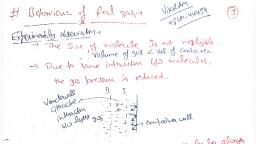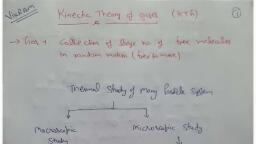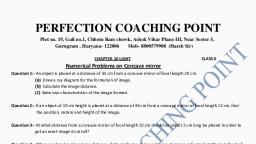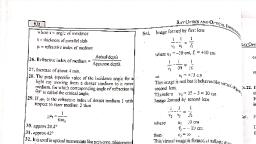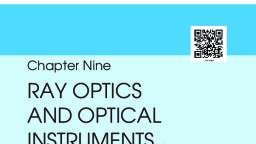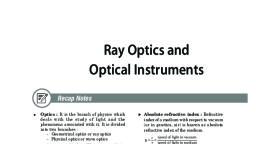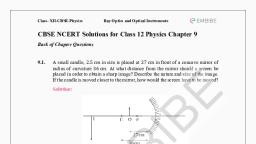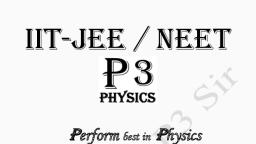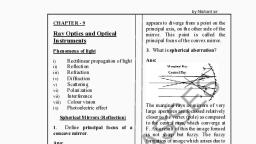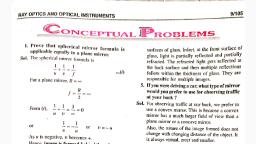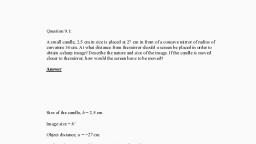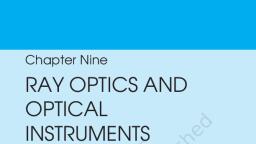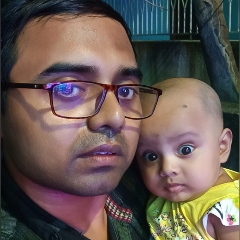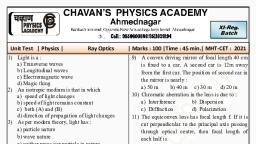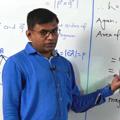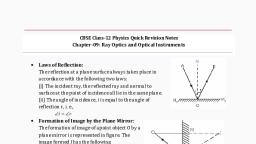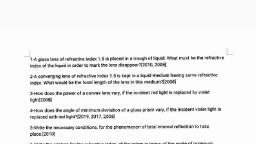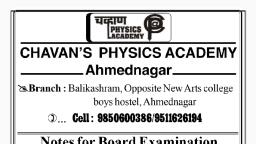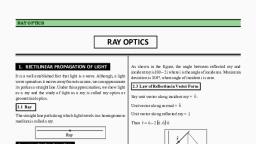Page 1 :
Linear Magnification Produced by a Lens (m)-, The linear magnification produced by a, the ratio of the sizZe of the, Lens is olefined as, image (I ) to the size of the object (0)., It, is represernted by m., Size of Image (AB'), Size of okiect, LAB), convex lens, when, image formed is real, as, figure, then-, In a, shown in, A'e', CB, B', AB, CB, B, +V, or, when image formed is virtual, as shoum° in' figure , then, A' B', %3D, AB, CB, or, B', B, Convex lens, Linear magnification is positive,, Thus in a, when image formed is virtual amd linear magni fication, is regative,'when image formed is rea., HO
Page 2 :
In a concave lens, image formed is atways, virtual, as shown in figure., So, A'B!, ce', AB, CB, - V, B F, B', or, %3D, 不リ, 一f, * Hence the linear magni fication in case of, Lens, 9 Concave, is always positive., Power of a Lens - (P), The ability of the lens to converge a beam of, on the ens is colled power ok Lens., light falling, It is measused as the reciprocal of tocal length of, the lens., 寺|, P =, According to lens maker's formula, (-1) (ই, - ), %3D, R2, - (h-1)(- ), or, P, %3D, For a Converging lens, power is posi tive omd for a, diverging Lens, power is negative., The SI unit of power is dioptre (D)., I cdioptre -, It is the power of a lens of focal length, one meter., when f is in, |00, Cm., P, %3D, f/100
Page 3 :
1Q., Find the radius of curvature of con vex Surface, CBSE, 2010, of, a plano convex lehs, whose föcal length iš o3m, ond, 1.5., Sol., RI, R2 = ?, > f= 0. 3 m,, = (41) ( - ), 공중 = (us-1)(-), foom, 100, 0:3X 0:5, 15, O.15 m., A Convex lens made up of glass of refractive index, 1'5 is dipped in tun, in, (a ) a medium of refractive index l-6s, (b), CBSE, 2011, a medium of refractive index, will it behave, 1-33, Converging or a, diverging lens, as a, in the dwo Cases ?, Sol. From Lens maker's formula -, * - ("lg - 1) (, R2, Or, R,, *Ug < "Alm for the first medium of refractive, As, index 1.65., And, index, a Mg > aMm for the second medium of refractive., 1.33., Hence, the value of focal length f will be negative., in the first medium, the diverging lens for the first medium., So the convex lens behaves as, The value of focal, the second medium , so the convex lens behaves as, the Convergig lens for second medium., length f will be pasitive in
Page 4 :
A beam of light Converges at a, Concave lens of focal length 16 cm.is placed, of thes beard, diagram and find, point P. A, CBSE, 2011, in the patth, ray,, * the, Cohverge ., 12 Cm. tcation, Draw, the location, pointt at Uwhich the beam would now, U =+12 Cm, = + 48 Cm,, 16 Cm., Using, lens formula, 1., 는 -, 16, 48, V= + 48 Cm., The image of virtual okject at p forms at p' which, is at a, distance, 48 Cm foom the dens., A, id placed 10ocm. from an, Screen, object. The, image os the object on the screen is formed by, Convex lens af two different locations, separated, 20 cm. Calculate the ocal length ok the ens used, CBLE, a, by, sol., object, Screen, object and screen, foom each other., are 1oo Cm., = l0o Cm., * V-u = 20 cm., Due to reversible image of light, 2)
Page 5 :
From equation O amd, we get -, V= 60 Cm., U = 40 Cm-, Now using lens formula, to - (), 60, 60, 24, = 24 Cm., &1Y०५ ०, of focal length 1o om. An object is kept at 1som, in front of E, as shown. The final real image is, formed at °the focus of I. Find the separation, between Li, L2 čind L3., Q You are, given three Lenses, L1 , L2 and La each, CBSE, 2-012., LI, L2, L3, sol., For Lens L,, Here u = -15 cm, and I, So that, = + LD Cm, =>, 30 cm, 1o, Herce Dis tance of image from Li is, For lens L3, V, = 30Cm., 1, Here, = + ID Cm, and, +10 cm., to - to, So that, 1, 1, 10, =>, The refracted rays from Lens ia becomes parallel, to principal axis., formed by Li lies at first focus. of Lz, distance o 10 Cm, . separation between L, and L2, The distance between L 2 and L3, It is possible only when image, i-e. at a, from L2., 30 +1o, : 40 cm., may take any value.., 介

